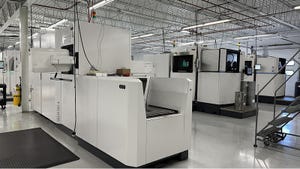With machine learning and artificial intelligence, manufacturers can eliminate maintenance guesswork and minimize unplanned machine downtime.
January 14, 2019
Predictive maintenance based on machine learning has reached the point where it can benefit virtually every manufacturer, big or small, an expert will tell engineers at the upcoming Pacific Design & Manufacturing Show.
Kayed Almasarweh, IBM’s Watson and cognitive solutions lead, contends that machine learning and artificial intelligence can minimize unplanned downtime, eliminate maintenance guesswork, optimize supply chain management, and reduce warranty costs in products, if used correctly. “This is not only for big manufacturing operations; it’s for everybody,” Almasarweh told Design News. “Once you get it implemented with the right data, you can get a return on investment almost immediately.”
Kayed Almasarweh of IBM: “This is not only for big manufacturing operations; it’s for everybody.” (Image source: IBM) |
Almasarweh will provide a high-level view of predictive maintenance based on machine learning in a session titled, "Applying IoT and Machine Learning for Predictive Maintenance," at the Anaheim Convention Center on February 6th. At the session, he will discuss challenges, successes, and lessons learned using real-life examples from industry.
Today, Almasarweh said, applications for predictive maintenance are widespread and growing by the day. The technology could be applied to CNC machines, assembly robots, conveyor belts, stamping machines, chain rails, locomotives, trucks, and just about any other imaginable factory asset, he noted. “As long as the asset is used by a business to generate revenue, make products, or move things, it’s a target for predictive maintenance,” he told us.
To a large degree, predictive maintenance is being fueled by the broader availability of data in virtually all kinds of businesses, Almasarweh said. Many businesses have sensors in place, as well as access to data storage in the cloud. Moreover, central processing units (CPUs) and graphics processing units (GPUs) have improved so dramatically in the past decade that many can now analyze hundreds of millions of transactions per second. Together, the sensors, storage, and computing capabilities are creating a foundation for machine learning and artificial intelligence that hasn’t been available previously.
“Data is the heart of being able to do machine learning and AI,” Almasarweh said.
RELATED ARTICLES:
To get started, some manufacturers may need to bring in past information, such as data about previous machine failures and parameters that were captured along the way to those failures. In those cases, the data may be stored on electronic media, or even on paper, in files or folders.
Once the data is available, Almasarweh said, implementation of predictive maintenance involves one of two approaches. Manufacturers can purchase a machine learning model or develop one themselves. Those who develop their own models tend to be larger enterprises with bigger engineering staffs.
Either way, he said, the potential benefits are there. “If your maintenance costs are spinning out of control and it’s keeping your plant manager up at night, then you probably need to look at predictive maintenance,” he said. “It’s something that works and something that keeps getting better with time.”
Senior technical editor Chuck Murray has been writing about technology for 34 years. He joined Design News in 1987, and has covered electronics, automation, fluid power, and auto.
|
About the Author(s)
You May Also Like




